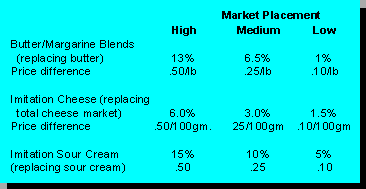
What is an Imitation Dairy Product?
Alberta legislation defines imitation dairy products as a food substance other than a dairy product, of whatever origin, source, or composition that is manufactured:
Margarine as defined in the Margarine Act or any product intended for use as a dessert topping, coffee whitener, or infant formula are not considered imitation dairy products. Similar legislation exists in every province in Canada with minor differences in the exception list.
Why Have Imitations Been Prohibited
Changes are Coming
The B.C. Experience
In the province of B.C. we realized several years ago that there were new dairy look-alike products on the market which contravened our legislation. Products were seized, pizza parlors were warned regarding imitation cheese toppings, much to the pleasure of dairy producers and to the displeasure of some importers, health food stores, and hundreds of consumers. They all made their views known to their political representatives and to us.
We were supported in our efforts to uphold the legislation. However, the Minister of Agriculture requested a review of the legislation pertaining to imitation dairy products. This began a long, arduous process which has reverberated across our nation.
The Industry Studies the Issue
Consumers, dairy producers and processors, importers, researchers, nutritionists, and regulators grappled with the legislative issues such as labelling, terminology, provincial differences, penalties, and nutrition standards. They discussed, but did not resolve the economic issues of protectionism, the fairness of cheap alternatives, and industries riding on the good reputation of the dairy industry. They called for an economic impact study which was completed some time later by the firm of Peat, Marwick, Stevenson, and Kellogg. Consumer issues included freedom of choice, low fat products, cholesterol, allergies, lactose intolerance, safety of imitation, labelling (and confusion) of products, and use of imitations in the restaurant trade.
The study group really wanted to know the consumers position on all of these and asked for further study which was awarded to the firm of Canadian Facts.
The Minister's Review - Key Findings
Remove Some Prohibitions. Food products which may or may not simulate dairy products should be permitted as long as they do not employ dairy terminology, dairy graphics, dairy packaging or promotion. They may be blends of dairy/non-dairy ingredients or entirely non-dairy.
They must not confuse the consumer and must have full disclosure of ingredients. Clearly, this requires legislative and policy changes right across the country.
Define Products. The report recommends that clearer definitions of dairy products and imitation products is essentially a national responsibility. Hopefully this will happen under the National Dairy Code which is presently under development.
Need for Consumer Research. The report further recommended that regulations should not restrict products to consumers when demands are based on philosophical, religious, and health reasons and called for a consumer study to determine needs and demands.
No Dairy Terms on Imitation. Dairy product terms must not be employed in imitation dairy products.
Restaurant Regulations. If allowable imitations are used in restaurants there must be clear notification. The study group went so far as recommending full disclosure of all food ingredients in restaurants.
No Confusion. There must be no confusion over terms used on labels, particularly those relating to health and nutrient claims and origin of ingredients.
One Song Sheet. There must be consistency across all provinces, therefore a need for Federal/Provincial cooperation.
Blends Should be Allowed. The development of this aspect of the food industry is now restricted - there should be room for the blending of dairy and non-dairy ingredients including fats and oils.
What Does The Consumer Want?
Those people (2%) that don't eat any dairy products cited allergies, fat, vegetarianism, and taste as the main reason for avoiding dairy products. Persons who limit their intake of dairy products do so mainly for health concerns; often on doctor's advice.
Consumers like to read labels and they want all the information they can get on a label; whether its a dairy product or an imitation. Generally, they would not choose an imitation, but they still want the freedom to choose. Interestingly, they did not view margarine as a substitute or imitation for butter. It is a product in its own right. In fact, of the 1000 surveyed:
All of those products are exempted from classification as imitations because they were thought to be imitations. Generally, consumers see these products as having fewer calories, less fat, are more convenient in some cases and for some, provide an answer to milk allergies. Some respondents even liked margarine, coffee whiteners, and frozen desserts. Price did not strongly feature in their choice of products. However, the economic impact study looked more closely at this.
The Economic Impact
 In the U.S.A. where imitations hit the
market in 1968 we found the following information, which may or may not represent an
intrusion into the U.S. dairy market. Imitation cheese (pizza cheese) has 2.8% of the U.S.
cheese market. Blends, butter-margarine has .3% of the Washington market. Imitation
sour cream has 11.2%. Whether this is a new market or an intrusion into the dairy
products market could not be determined.
In the U.S.A. where imitations hit the
market in 1968 we found the following information, which may or may not represent an
intrusion into the U.S. dairy market. Imitation cheese (pizza cheese) has 2.8% of the U.S.
cheese market. Blends, butter-margarine has .3% of the Washington market. Imitation
sour cream has 11.2%. Whether this is a new market or an intrusion into the dairy
products market could not be determined.
In order to determine whether consumers would be willing to purchase lower priced imitations the study asked a group about price considerations for several scenarios. From that an estimate of the impact on the intrusion into the B.C. market was made.
Displacement Rates
It was estimated that a total of 4,382,000 litres of milk would be displaced by deregulation in B.C. or .9% of our annual production although this could range from 0.4% to a high of 1.7% of total milk production based on the high and low estimates.
Can the dairy industry financially and emotionally handle a change like this in addition to the new world trading environment? There are opportunities as well as threats for the industry to deal with. I'd like to summarize those now.
Opportunities for the Dairy Industry
The dairy industry should have the opportunity to participate in:
Threats/Needs
Conclusions
There are seven principles emerging from those talks and they are based on studies and experience in other countries. I believe these summarize how we will proceed in the future:
1. Dairy products and vegetable oil/protein based products are separate and distinct products.
2. Consumers should have access to both.
3. Neither should purport to be a substitute or imitation of the other.
4. Nutritional equivalency is not an option.
5. All food products shall declare all ingredients.
6. The name of either product should be distinct and not infer it is a substitute for the other.
7. Blends of two or more distinct products should have unique names, yet clearly indicate the nature and proportion of the contributing products.
Will imitations siphon the profits out of your industry?
The answer is summed up in the motto of my University, UBC, "Tuum est" which means it is up to you. It is up to all of us to make this a win-win situation for consumers, processors and producers.
References